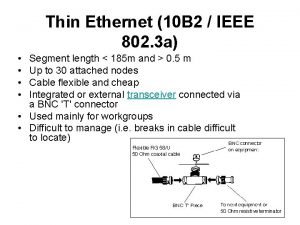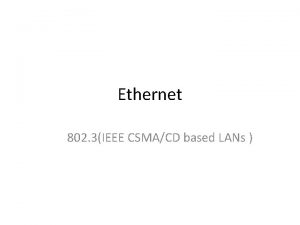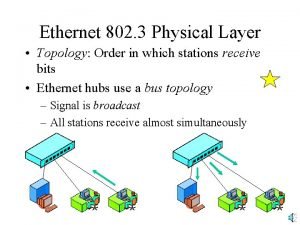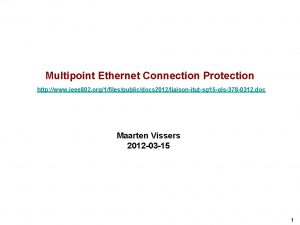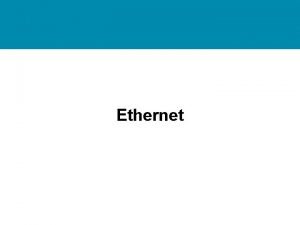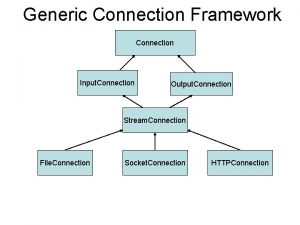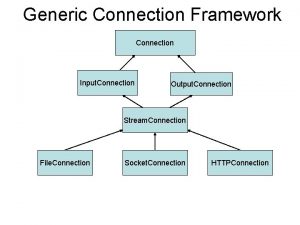Multipoint Ethernet Connection Protection http www ieee 802

![Introduction [G. 805] Protection – This makes use of pre-assigned capacity between nodes. The Introduction [G. 805] Protection – This makes use of pre-assigned capacity between nodes. The](https://slidetodoc.com/presentation_image_h2/6a8bcb14541a8c2b74993bbbe0a645e4/image-2.jpg)




- Slides: 6

Multipoint Ethernet Connection Protection http: //www. ieee 802. org/1/files/public/docs 2012/liaison-itut-sg 15 -ols-378 -0312. doc Maarten Vissers 2012 -03 -15 1
![Introduction G 805 Protection This makes use of preassigned capacity between nodes The Introduction [G. 805] Protection – This makes use of pre-assigned capacity between nodes. The](https://slidetodoc.com/presentation_image_h2/6a8bcb14541a8c2b74993bbbe0a645e4/image-2.jpg)
Introduction [G. 805] Protection – This makes use of pre-assigned capacity between nodes. The simplest architecture has one dedicated protection entity for each working entity (1 + 1). The most complex architecture has m protection entities shared amongst n working entities (m: n). Protection switching may be either unidirectional or bidirectional. Bidirectional protection switching takes switching actions for both traffic directions, even when the failure is unidirectional. Unidirectional protection switching takes switching actions only for the affected traffic direction in the case of a unidirectional failure. [G. 805] Restoration – This makes use of any capacity available between nodes. In general the algorithms used for restoration will involve rerouting. When restoration is used some percentage of the transport network capacity will be reserved for rerouting of working traffic. Ethernet Connection Protection – The operator, a network management system or the ASON/GMPLS control plane will select a subset of the links and nodes inside the network to transport the EC signal. The EC’s VID value(s) will be registered on each of those selected links to establish the EC’s link connections. This VID registration is fixed and will not change under fault conditions. An APS protocol within the EC is responsible to chose a subset of these link connections/nodes within the EC to transport the traffic from input ports to output ports. Ethernet Connection Restoration – The operator, a network management system or the ASON/GMPLS control plane will select a subset of the links and nodes inside the network to transport the EC signal. The EC’s VID value(s) will be registered on each of those selected links to establish the EC’s link connections. This VID registration is dynamic. Under fault conditions in the network the set of selected links and nodes is changed to restore the EC and the EC’s VID value(s) are then registered on the set of alternative links and nodes. 2

EC Protection Well known protection architecture types are q q q 1+1 Protection – Diversely routed Working and Protection EC Segment Connections are set up between the protected EC Segment end points and traffic flows are transmitted over both W and P EC segment connections; at the EC segment egress points traffic flows are read from either Working, or Protection 1: 1 Protection – Diversely routed Working and Protection EC Segment Connections are set up between the protected EC Segment end points and traffic flows are transmitted under normal conditions over the W segment connection and read from this W segment connection at the EC segment egress points. Under fault conditions or under control of “external commands” traffic flows are transmitted over and read from the P segment connection. 1: n, m: n and (1: 1)n Protection – Diversely routed Working and Protection EC Segment Connections are set up between the EC Segment end points. In 1: n case, n W and 1 P segment connections are set up. In m: n case, n W and m P segment connections are set up. In (1: 1)n case, n W and n P segment connections are set up. In all cases, the protection bandwidth is shared amongst the n protected EC signals. 1+1 and 1: 1 protection architectures are the commonly deployed architectures for bidirectional P 2 P connections; 1+1 protection architecture is the commonly deployed architecture for the unidirectional P 2 P and P 2 MP connections 1+1 and 1: 1 RMP and MP 2 MP protection architectures can be used to protect RMP ECs and MP 2 MP ECs. q q A necessary precondition is that W and P EC Segment connections can be set up with complete route diversity. A multipoint version of G. 8031’s ETH SNC APS protocol will provide protection control. 3

RMP and MP 2 MP EC Segment Protection Complete route diversity for W and P EC Segments may not be achievable in all cases, e. g. when the number of ports for an EC is large RMP ECs (without leaf groups) may in such cases be protected by means of more complex architectures; e. g. with a shared protection tree and multiple working trees (n working trees with different leaf sets are protected by 1 protection tree reaching superset of leaves) MP 2 MP ECs and RMP ECs with leaf groups can not be protected with such shared protection tree and multiple working trees An alternative RMP and MP 2 MP EC Segment protection architecture would be using an Ethernet Connection which includes additional link connections and nodes (but does not have separate Working and Protection EC Segments); result is that there is “more than one path between any input port and any output port” q q q Those additional link connections/nodes introduce loops in the EC and the EC is not longer “treestructured” Such EC however has build in path redundancy that can be deployed to restore the traffic flow connectivity between all input and output ports under link or node failure conditions Refer to such EC as a “Redundant EC” 4

Redundant EC Flooding and MAC learning can not be used in a Redundant EC; instead an alternative flow forwarding computation and distribution protocol must be deployed within a Redundant EC SPB or ECMP-SPB protocols are natural “flow forwarding computation and distribution protocol” candidates So far SPB expects have been indicating that those protocols are not optimized for Redundant ECs But wouldn’t it be possible to deploy a Redundant EC optimized SPB/ECMP-SPB protocol? Redundant EC characteristics q q q q A Redundant EC is a Service layer EC, which carries an E-Tree or E-LAN EVC between the EVC’s UNI-N ports, or between the EVC’s UNI-N and E-NNI ports, or between the EVC’s E-NNI ports The UNI-N ports for this Redundant EC may contain an I-component and a CBP; if present, the Redundant EC is a B-VLAN, with B-MAC addresses inserted at the UNI-N ports, operating at the Service layer; i. e. it is operated as a “Service VLAN” with “Service MAC addresses” (which are inserted by the PIP in the UNI-N port) and a single I-SID value A Redundant EC has N ports (N 2) and at least two paths between any input port and any output port A change in the fault (or degradation) status in one or more of the Redundant EC’s link connections and/or nodes, or a change of an external command status triggers a flow forwarding recovery action in the Redundant EC SF (and SD) status is monitored for each of the links (or link connections) in the Redundant EC The Redundant EC’s APS OAM channel can transport the Redundant EC optimized SPB or ECMP-SPB protocol messages Multiple independent Redundant ECs may be present in the transport network’s service layer, each performing its own (ECMP-)SPB based APS protocol 5

Thank you 6


